Hello friends! Today Vladimir wrote for you an extremely useful
and a very relevant article about choosing a processor for a laptop!
Confess when was the last time youWe were in a computer store and were choosing a laptop (and choosing any laptop starts with the processor), then we completely trusted the seller, since all these names of processors and video cards, with some kind of letter designation U, M, MQ, N, A6, R5, MX, you've only been confused. As a result, already at home you figured it out a little and realized that you bought the wrong thing, because new laptop (for 45 thousand rubles)It doesn't work that fast, and all games run only on low settings!And I understand you perfectly, because now is a difficult time and in order to have the maximum possible profit, the manufacturer is going Sometimes for various marketing tricks, sometimes selling us the “newest” processor, which, upon closer examination, can hardly be called the newest, since according to all test results it is inferior to the old processor produced 5 years ago.
Up to 40% more energy efficient and up to 35% higher than its predecessors. The company has already detailed what it promises are big improvements aimed at the economical and intermediate consumer, more economical, smaller and most interestingly: yet more powerful.
The company pays great attention to working with portable devices, as well as high-performance computers. But for those who want state-of-the-art capabilities, with super powerful hardware for heavy-duty tasks, the thought must be different. But in general, they should have basically similar characteristics.
When I asked this question to the general manager of the Moscow HP store (Hewlett-Packard), he answered me like this:" IN Nowadays, manufacturers of mobile processors prioritize low energy consumption, since it is believed that the device, first of all, should consume less energy and work autonomously for a long time on one battery without recharging, but you remember from school physics that mThe instantaneous power over a period of time is equal to the total transferred energy, and if this energy is not enough, then where will the power come from?»
Therefore, apart from them, what will matter is even a set of other specifications. Researching the processor model is very important when choosing a computer. When the machine is a gaming laptop, this task becomes even more delicate. Issues related to core count, architecture, and power consumption are important when comparing processors.
Choice ideal processor gentle for a laptop. Unlike desktop computers, if necessary, it is impossible to replace the processor. You can find computers offering processors different generations. In this case, the tendency is for the new architecture model to have more advantages over the previous generation.
In simple words friends, most modern laptops (priced 40-50 thousand rubles!) are equipped with low-power but economical processors. Then the question! If we want to play modern games on a laptop without lags, then what should we do? How to choose a processor for a laptop so that the computer device itself is powerful and inexpensive? In today's article we will try to answer all these questions and tell you how laptops sold in stores differ.
Laptops don't allow you to switch the processor, making it a delicate choice. Is the CPU important for gaming? This is a question about the type of game and the claims you have with your machine. Typically, the heavy lifting in terms of effort to run a game on a computer is done with the graphics card: this is where the physics simulations that affect the game's graphical quality are performed.
This means you can save some money by choosing less powerful processor and investing in a higher quality graphics card, which makes sense if your laptop ambitions involve gaming a lot. Time battery life is a sensitive point for those who choose laptops. This means that each new generation of processors brings significant energy savings. The more power a processor dissipates, the more energy it uses to operate, indicating better performance.
Portable computers (laptops) are very popular today. A very large number of people have a desire to buy a new laptop and, as they say, demand creates supply. The stores offer dozens of models from various manufacturers. Most buyers who come to the store see this abundance and their eyes begin to wander, which laptop should they choose.
In this aspect you need a trade-off between consumption and performance. Gaming is a complex task that uses a lot of machine resources. In this sense, there is no doubt: a processor with the most cores will outperform a processor with fewer colors available. Another important point is speed. The more gigahertz a processor reaches, the faster it runs.
In the middle of the alphabet soup and numbers that characterize the nomenclature and determine which scenarios the processors were considered for, there are a few you need to know to avoid disappointment in the future. Among them are models designed for ultrabooks. These processors provide more consistent performance, lower power consumption, and a smaller color gamut.
There are several companies that produce laptops (Asus, Lenovo, Acer, etc.). We will not talk about which company is better, it is incorrect in relation to them. Moreover, they all use the same components (processors, video cards, etc.). But we'll talk about components.
All components installed in the laptop are called in one word - " Hardware platform". The basis (foundation) of the hardware platform is the processor, CPU in Russian, CPU in English.The choice of processor determines whether our laptop will be new or not quite new, low-performance or high-performance, with reduced or increased power consumption.
Go out to get information about the machines you're comparing to find benchmark tests. If you're not familiar with this type of comparison, just know that these are tough tests that force computers, and therefore their processors, to the limits when comparing gross performance.
Finding the ideal computer for each type of user necessarily depends on the choice of processor. Although it is less important for more powerful devices, the processor still plays a key role in classifying the performance capabilities of any computer. Computer for school work and surfing the Internet.
Processors are produced by 2 companies: Intel and AMD. AMD loses in demand Intel. E If in 2006 sales of AMD and Intel processors were 50 to 50 percent, then in 2010 it was 30 to 70, and now only 18 percent of buyers buy AMD, the remaining 82 percent buy Intel.
Both companies constantly update their processors (about once a year). The update does not change the name of the processor; for example, Intel's Core i3 remains Core i3, and AMD A8 remains A8. The update changes the generation of processors, stores do not have time to sell the previous generation, and manufacturers offer a new one, stores now sell 4 lines of Intel processors for laptops (there is also Xeon, but this is for mobile workstations):
Let's assume that the user need is more common: your computer needs to run text editors and more simple images and browse the Internet. In this range, you need basic templates: they process the order and cost less. Moderate use of multimedia features.
For those who need to use word processors, browse the Internet, and ultimately watch a movie or TV series on the computer, a slightly more powerful processor is required for smooth performance. In this case, we are talking about a demanding consumer who depends on the most powerful machine.
Intel Core- the most productive processors!
Intel Core M- average performance processors.
Intel Pentium - below average performance.
Intel Celeron- low performance processors.
Each line has several generations of processors. Let's look at each line in detail!
Intel Core
Core i3 is the weakest in the line.
Many users have doubts about which laptop to buy. The main difference is in processing power, but depending on daily use, the investment isn't always worth that much. The main difference is how the processor is able to handle different tasks to make the machine faster.
Want to learn more about technology? So check out these tips and see which device is right for you. The idea is to understand what is the difference between quad core and dual core laptops. It is capable of processing various tasks to speed up the machine while performing activities.
Core i5 - average capabilities.
Core i7 - the most powerful.
Today, 4 generations of processors are sold Intel lines Core.
Haswell- year of release 2013 ( 4th generation).
Broadwell- year of release 2014 ( 5th generation).
Skylake year of release 2015 ( 6th generation), exactly from this Intel generation began producing quad-core i5 processors.
So dual core is two cores and quad core is four, resulting in more power. Keep in mind that not all programs require quad-core processing, and the price on this latest laptop may not be worth it. First of all, it is important to think about what functions the computer will have in everyday life, with all the programs you want to install and use at the same time.
If you are considering a laptop only for lighter entertainment, such as browsing the Internet to access social networks, Email, saving photos and more simple programs, the dual-core model will satisfy these needs without any problems.
Kaby Lake appeared quite recently ( 7th generation).
You can determine which generation by the first digit, for example:
Core i5-4 200U - 4th generation Haswell (2013)
Core i7-4 510U - 4th generation Haswell(2013)
Core i5-5 200U - 5th generation Broadwell (2014)
Core i7- 5 500U- 5th generation Broadwell ( 2014)
Core i3-6 100U - 6th generation Skylake(2015)
However, whether you are looking for a professional laptop or running games, photo editing programs, videos with more high quality, which means more intensive use. It's worth researching whether the model is still in production by the manufacturer or if it's out of order before purchasing. This ensures that parts are replaced much more easily, without having to wait too long for service.
It is the successor to the main duo with 5-20% faster pipelines without additional consumption. The energy requirements of processors are indicated by predefined letters in front of the designation type. It is the successor to the main solo and is technically the core of the 2nd duo 2 with a single core. Therefore, the voltage across the core is very low. At that time, 2 versions were predicted.
Core i5-6 200U - 6th generation Skylake(2015)
Core i7-6 500U - 6th generation Skylake(2015)
Core i7-7 500U - 7th generation Kaby Lake (2016)
Core i7- 7 Y75- 7th generation Kaby Lake (2016) ), you may have noticed the letter Y in the name of this processor; what it means will be discussed in the next section of our article.
Intel Core M
Core has it lowest power processors Y and This is where things get a little more complicated.I don't remember when they appeared, but Ivy Bridge they were Core i3-3229Y.
Both cores are automatically lowered and independently of each other in steps of up to 1 gigahertz. In comparison, we very quickly see very modest speeds with weak floating point operations. It is also available as a low voltage version with very low current consumption.
All models support execution interrupt bit function and 64-bit compatibility. The 45nm version consumes less than the 65nm. It is powerful enough for office applications. It does not support any revival technology. In computing, as elsewhere, it's not just about performance, which is why our picks are these computers with great autonomy and fairly quiet processors.
Intel Core M start with the 5th generation and there are three generations on sale: 5, 6 and 7.
In the 5th generation Y was singled out separately and they became not Core i, but core M (without i 3, i 5, i 7), for example - Core M 5Y31.
In the 6th generation they were divided into M 3, M 5, M 7 (Core M7-6Y75, Core M5-6Y57, Core M3-6Y30).
In the 7th generation there is only M3, for example - Core M 3-7Y30, but at the same time for i5 and i7 they returned Y ( Core i5-7Y54, Core i7-7Y75).
These are small computers with configurations that are often lightweight, but their mobility, lightness and autonomy make them ideal partners for many users. For the student who wants a quick lesson for those less comfortable with computers, this little son of a netbook will be happy.
To better understand whether such a computer is made for you, do not hesitate to consult on this issue. The first of these options is in the air of time, with its touch screen and hinges able to withstand all the distortions and air of the hybrids.
Core M3 - the weakest processor in the line, for example (Intel Core M3-6Y30).
Core M 5 - average capabilities.
Core M 7 - The most powerful.
You can also determine which generation by the first digit, for example:
intel Core M 5 Y31 - 5th generation, based on architecture Broadwell (2014)
intel Core M7-6 Y75 - 6th generation, based on architecture Skylake (2015)
We regret the definition of a little weak, but it should make the illusion on slab 11. Its sober design will please purists and indifferent indifferents, so it's perfect. It's up to you to decide what you prefer. The design is frankly successful, simple, with a pleasant touchpad and a nice keyboard.
Need a laptop?
Overall, they need to attract attention. Today, tablets have features similar to laptops, but what about the keyboard or screen size? If you want a laptop that also doubles as a tablet, make sure you find your bliss. Yoga 710 is a perfect example.
intel Core M 3- 7 Y30- processor 7th generation of this line, based on the latest architecture Kaby Lake (2016) and performance is approximately equal intel Core i5-4200U, but during long-term operation it is still inferior to it due to very low power consumption (TDP) - only 4.5 W.
Pentium and Celeron are manufactured based on the Atom core and based on the Core core.
Laptop yes, but at what price?
There are often several configurations of “one” computer. Therefore, it is important to check these specifications of each computer before purchasing. Links in this article refer to specific models that we tested. There's something for every budget. Please note that these are intended for basic use, such as surfing the Internet, sending emails, or editing documents.
Select screen size
If you have a small budget, feel free to consult our article. In recent years the average range has been around 500 euros. Laptop screen size is another important criterion before proceeding to checkout. Their size ranges from 11 to 17 inches.
And created on the basis Core, have the letter U or M in the name, for example: Celeron 3855 U, Pentium 3560 M. They can handle light and medium tasks - Internet surfing, office applications and working with simple graphics.
Determine the release year of the processor you can also use the first digit,
2 - year of release 2013 and 2014, for example: Celeron 2 970M.
3 - year of release 2015 and 2016, for example: Celeron N 3 010.
If your laptop is the type that follows you wherever you go, go small screen! However, it does say that the small talk about “visibility”, especially when you have to work at it. Also keep in mind that a computer this size will have less storage space and fewer features such as external ports.
The 13-inch screen is the perfect balance between portability and use. If you need touch screen, he will tell you, it will cost you a little more. Also note that most laptops have a shiny display, although most users prefer matte screens. Indeed, on this type of screen, the brightness can be reduced to 40% of its total capacity, which is more convenient for long-term use. Although a glossy computer used outdoors or in a very bright room may interfere with its reflections.
3 - year of release 2014, for example Pentium 3 560M.
4 - year of release 2015 and 2016, for example: Pentium 4 405U, Pentium N 4 200.
Note: with number 3 in Intel they were too clever.
2013 (3558U, 3556U, N3510)
2014 (N3540, N3530, 3560M)
2015 (N3700, 3825U, 3805U)
2016 (N3710).
AMD has the same as Intel Core, The first digit indicates the year of release:
5 - 2013 (A6- 5 200)
6 - 2014 (A6- 6 310)
7 - 2015 (A6- 7 310)
9 - 2016 (A6- 9 210)
- The processors differ significantly in performance. Intel has the lowest performance Celeron N, and the highest performance Core i7 HK is a four-core processor with an unlocked multiplier (overclockable processor), the difference in performance between them is very large, Celeron is 11 times weaker.
AMD does not have high-performance laptop processors, the most powerful is the AMD FX-9830P (latest generation) and it is lower in performance than the 4-core Core i5. AMD's lowest-performance processor is the E1, equal to the Celeron N.
Laptop processor power consumption
Intel processors (Core M, Celeron N and Pentium N) have the lowest power consumption.
U processors have higher power consumption and M and H processors have even more.
Four have the highest power consumption nuclear processors: MQ, HQ, HX, HK.
They do not produce 4-core U and Y processors.
The lower the power consumption, the lower the performance of the processor model!
The Core M3 processor is lower in performance than the Core i3 U.
The Core i3 U processor is lower in performance than the Core i3 H.
Celeron N is lower in performance than Celeron U.
With AMD also, the weaker the processor, the lower the power consumption.
If you want to buy a laptop with an Intel processor, then pay attention to the letters in the name of the laptop.
Y - processor with low energy consumption; 11 W
U - ultra mobile processor, low energy consumption; 15-25 W
M - mobile processor; 35-55 W
Q - quad-core processor; for example Intel Core i5 7300HQ. Score 6942
X - extreme processor; an expensive top-end solution, for example Intel Core i7-3940XM. Score 9372.
H - processor for gaming laptop with a powerful video card, for example Intel Core i5 7300HQ. Score 6942, it usually comes with a GeForce GTX 1050 gaming video card.
K - the processor has an unlocked multiplier (overclocking is possible), for example Intel Core i7 6820HK. Score 9062.
Laptop video card
- The more powerful the additional video card, the more powerful the processor should be! Gaming graphics require a large number of complex calculations, so laptops are equipped with additional video cards based on processor power and customer needs.
Laptops come with one video card (built into the processor), it is also often called “integrated”,
and come with 2 video cards: built-in and additional (discrete). When we turn on the laptop and the desktop appears, this is the work of the built-in card (the processor processes the data and the video card displays the image on the screen), we open the browser and this is the same work of the built-in card. The built-in "integrated" card works with the vast majority of programs, which is why half of the laptops sold have one video card.
The additional (discrete) video card works mainly with 3D graphics (for most users this is games).
3D graphics vary in severity (quantity and quality of objects), so additional video cards are produced in different capacities
Video cards for general use are produced by AMD (Radeon video cards) and Nvidia ( GeForce video cards).
FirePro (AMD) and Quadro (Nvidia) professional cards will not be discussed.
Today, stores sell three lines of mobile Radeon video cards.
R5 is the lowest in performance.
R7 - higher performance.
R9 are the most powerful cards.
Each line has a series:
M200 series released 2014
M300 series released 2015
M400 series released 2016
The M400 series is represented by the following video cards: R5 M435, R5 M430, R5 M420, R7 M465X, R7 M465, R7 M460, R7 M445, R7 M440, R9 M485X, R9 M470X, R9 M470.
Nvidia, as such, does not have lines; it has a division between GeForce from 10 to 40 and GeForce GTX from 50 to 80.
The first digit indicates the year of release.
7 - year of release 2013 (example - video card GeForce GT 750M)
8 - year of release 2014 (example - GeForce GeForce 820M)
9 - year of release 2015 (example - GeForce GeForce 940M)
the second digit means productivity, the lower the number, the lower the performance:
810M 820M ....880M
910M 920M ....980M
In 2016, GeForce 920MX, 930MX, 940MX video cards appeared and they are 30 percent more productive than the 920-940M, as well as GeForce GTX 1050, 1060, 1070, 1080 (they don’t have M mobile) they are 2 times more productive than 950-980 video cards M.
Power determination laptop processor and video card
Buying a laptop begins with viewing the models offered in stores. We offer simple and quick way to determine the power of the processor and video card.
There is a website on the Internet PassMark http://www.passmark.comand there is a very large database of performance test results for all existing processors, video cards, as well as random access memory And hard drive. Based on these tests, a performance index is derived. TOWe'll show you how to use the site using the example of choosing a laptop.
So, we have 2 laptops with the same price.
HP Pavilion 15-au107ur, Z3B14EA(with Intel Core i5 7200U processor)
Lenovo B5180, 80LM012URK(with Intel Core i5 6200U processor)
Let's check the processor performance rating.

Go to the website http://www.passmark.com and enter the model in the search box Intel processor Core i5 7200U installed on an HP Pavilion 15-au107ur laptop, click on the Magnifying Glass icon (Search).

The page will open,select the line with the name of the desired processor Price perfomance comparison, here it is number 1 (but may not be the first number) and click on it with the mouse.
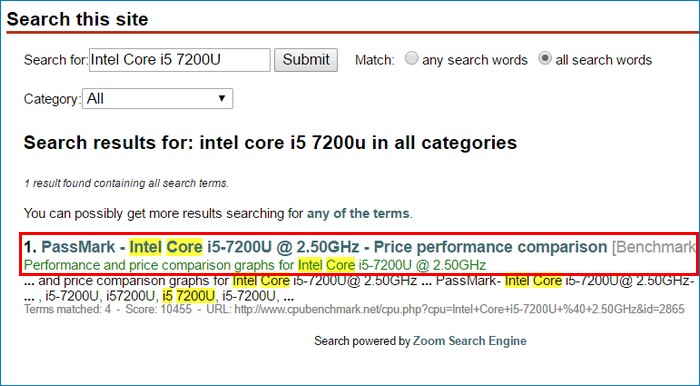
In the window that opens we see the average performance rating is 4725, and the average performance of one core is 1747 (by the way, the number of cores misleads some buyers, for example Pentium processor N3710 is quad-core, but the performance rating for one core is 571).
We also see more information:
These processors were tested on 281 laptops.
Minimum power consumption (TDP) 7.5 W.
Maximum power consumption ( TDP) 15 W.
The year of appearance of laptops with this processor is 2016.

Let's check the performance index of the second processor, the steps are the same.
Enter the model of the Intel Core i5 6200U processor installed on the laptop into the search window Lenovo B5180 , click on the Magnifying Glass icon (Search).
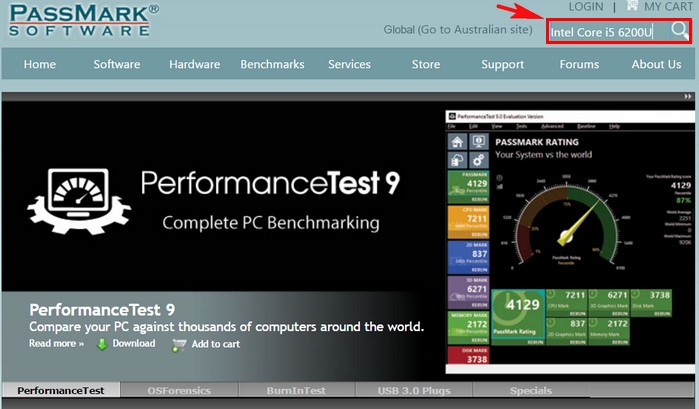
A page will open, select the line with the name of the desired processor Price performance comparison and click on it with the mouse. 579.
The year of appearance of laptops with this video card is 2016.



What games and at what settings can the video card of this or that laptop run?
Performance assessment hardware platform We have learned about our laptops and already have a real idea of which is better and which is worse (despite the same price), but most users are also interested inwhat games and at what settings the video card of this or that laptop will run. DTo do this, go to another site
On the left side of the window that opens, enter the name of the GeForce 940MX video card in the input field. On the right side of the window, select the game we are interested in from the list (I will select Resident Evil) and click the "Show" button
Left click to enlarge the screenshot
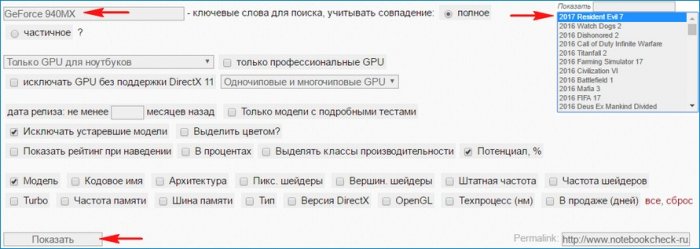
a page with the result will open. PIn terms of gaming performance, this video card ranks 182nd. M This is determined for all cards, not just mobile ones. We also see that 61% of users played the Resident Evil game with 61 fps at low settings. 27.9 on medium and 15.2 on high.

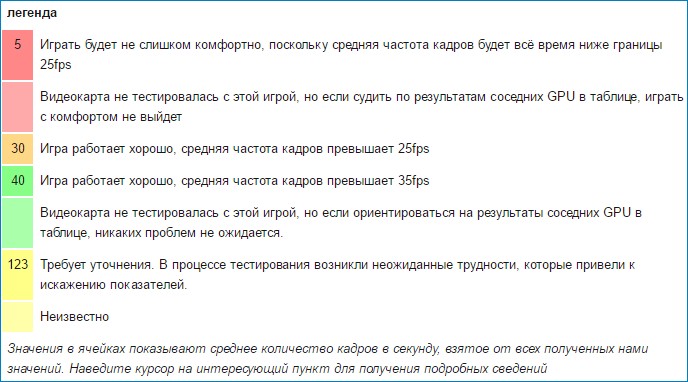
In this window you can select several games at once. Hold down the Ctrl key and highlight the games you are interested in, then click the "Show" button
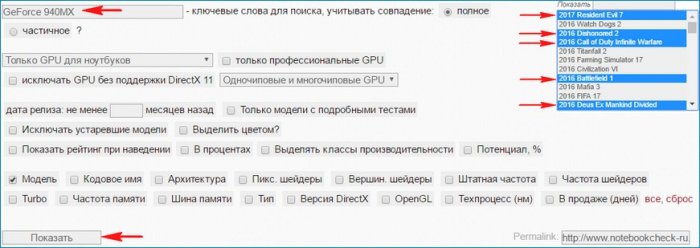

We perform the same actions with the AMD Radeon R5 M330 video card.
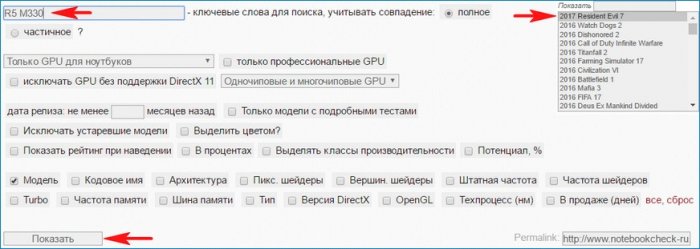
P Regarding gaming performance, this video card ranks only 337th and unfortunately not tested with Resident Evil game.
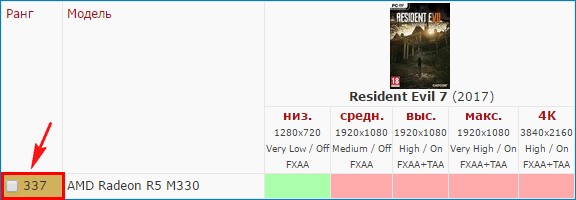
This is how you can compare laptops offered in stores.
How to view performance ratings on the PassMark website all the components of your laptop
Return to the site http://www.passmark.com
Select Benchmarks, then CPU Benchmarks.
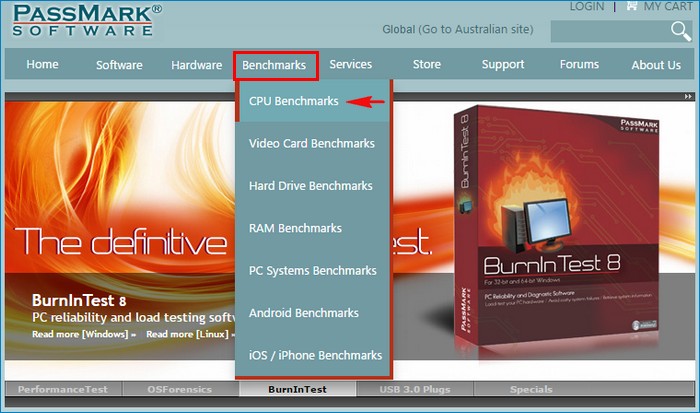
Select Laptop/Portable CPU Chart

In this list you can find the processor you are interested in and compare its rating with the rating of any other processor.
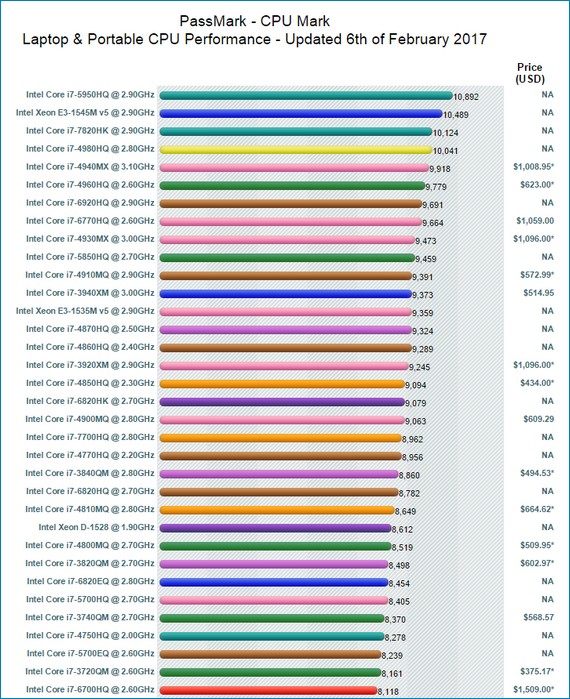
We compare video cards in the same way.
Select Benchmarks, then Video Card Benchmarks.
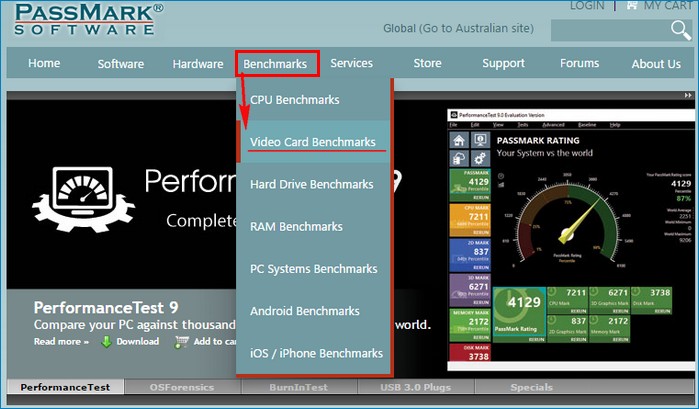
![]()
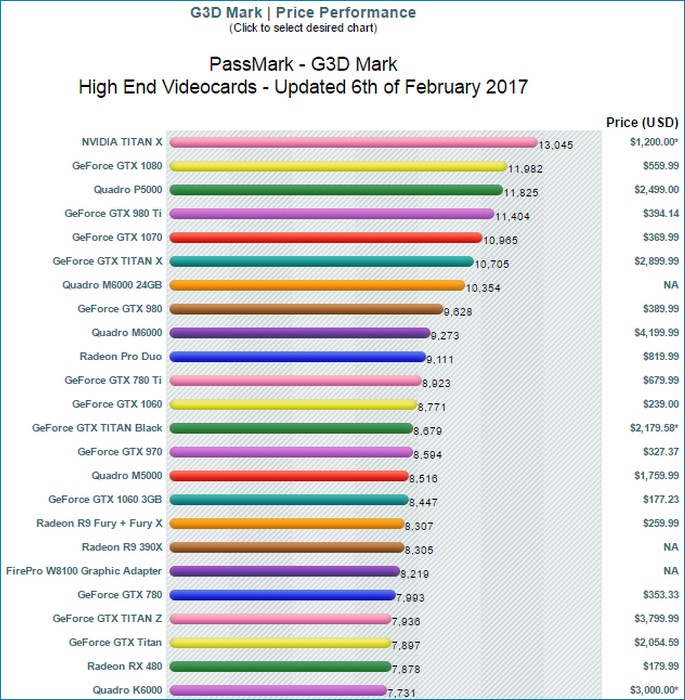
Performance ratings of components of a regular computer or laptop based on the PerformanceTest program
Users from all countries test their laptops and computers using this program and add test results to the database.
For example, I suggest testing Acer laptop Aspire E5-573G-31V3 with Intel Core i3 5005U processor and GeForce 940M video card.
Download the PerformanceTest program.
Software-->PerformanceTest
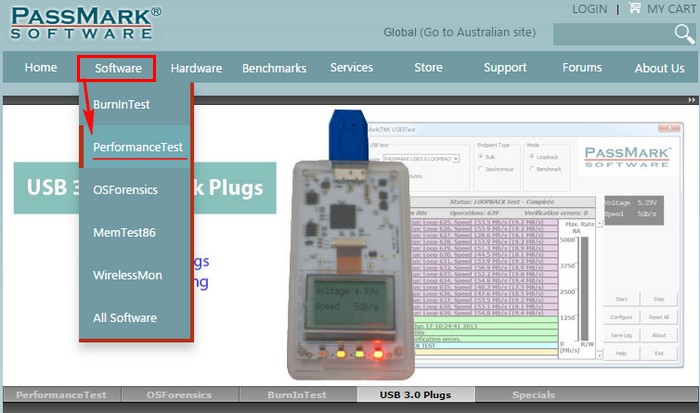
Download Download PerformanceTest 9.
If you have an old one operating system, then you can download below previous versions programs.
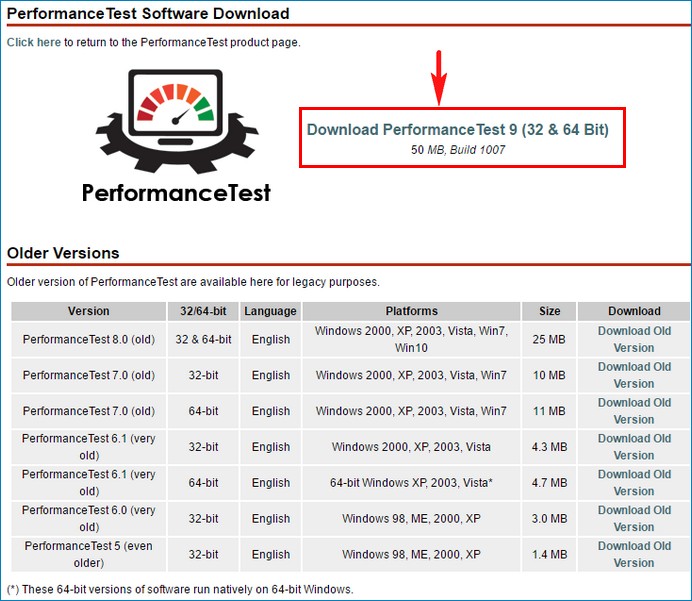
We install the program.
The installation process is very simple, you just need to accept the license agreement.
Launch the program after installation.
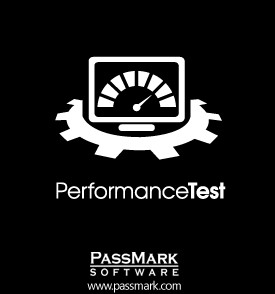
Click on the Continue button.
If you want to test all the components of your computer or laptop at once (you can also test them separately), then click on the RUN BENCHMARK button.
The test of the processor begins, then the video card, RAM and hard drive.
To ensure that the test score is accurate, do not run any applications on your computer or touch the mouse during the test. The test itself will last no more than five minutes.
During the test, the processor is loaded with various computing operations.
For the video card test, the PassMark PerformanceTest program creates exactly the same load that would occur during the most demanding computer game.The video card is also tested for 2D and 3D graphics. As you know, graphics come in 2D and 3D.
2D graphics is responsible for displaying a two-dimensional image: displaying the desktop, watching videos, and the like.
3D graphics are responsible for displaying a three-dimensional image: displaying all the details of a modern game; the application environment is also tested here: DirectX 9, DirectX 10, DirectX 11, DirectX 12.
RAM test. Checked throughput random access memory.
The hard drive test looks like writing small blocks of data to it.
At the end of all tests, we get an overall assessment of the configuration of our laptop. On the right side of the window we see individual ratings of all components. Of course, the result is not so great, but this laptop costs more than forty thousand rubles. The Intel Core i3 5005U processor score is 2679, and the GeForce 940M video card score is 1479.
The program offers to enter test results into its database.
The result (in the form of a report) will always be available via the link:
http://www.passmark.com/baselines/V9/display.php?id=73690558801
The main PassMark PerformanceTest window will also display the test results of each component with all the details, for example, click on the GPU MARK button and you will see all the tests performed on the processor.
The program allows you to compare performance ratings various models computers and laptops. You don't have to test your car.
Launch the program and click on the Manage Baselines icon
In the window that opens, click Currently Selected.
The program offers you to compare your assessment with the assessments of these models. We don’t need this now, so we clear the list (uncheck the boxes) and return to the search, click on the Simple Search button
You can search by processor, video card, disk and model. As an example, let's search on a video card.
Enter the name of the video card in the input field, in my case - 940M and click on the Search button.
and select several models (check them), click “Close”,
Then we return to the main program window, press the PASSMARK button, then the View chart and compare the selected models.
If you have tested your laptop's video card in the program PerformanceTest, then your result will be displayed here. I look forward to your questions about the article. Articles on this topic:
The development of modern means of content consumption (smartphones and tablets) has defined the laptop as a separate segment of mobile electronics. With its help, they create materials, solve production and management problems, and play games. Which processor is better for a laptop depends both on the mode of its use and on the tasks it solves. You should select the “brain” for such a portable computer with a reserve: in the future, an upgrade may be impossible or cost additional costs to pay for the work of specialists.
Main characteristics of processors
There are several basic parameters to choose from. Which processor will be better for a laptop with your needs depends on the tasks being solved and the budget. Let's look at the main characteristics:
- Manufacturer. In fact, the chip market is occupied by two competing companies, AMD and Intel. They occupy 98% of the sales market and have virtually nothing to compete with other manufacturers. The remaining 2% is shared by VIA, ASUS and Acer, but the products of these companies do not withstand minimal competition, and their processors are not worth buying.
- Number of Cores. The performance of laptop processors depends on this number, but not only. If the device will be used as a gaming device, then with the same budget you should give preference to a higher frequency rather than the number of cores. To solve problems of video processing or large photos, the priority is the cores, here they will work to the maximum.
- Connector type (socket). The chip is installed on the computer motherboard in a special place - a socket. motherboards not universal: if the motherboard is designed for an AMD chip, then it will not fit Intel, and vice versa. Sockets within the same manufacturer also differ. When choosing, be sure to make sure that the connector on the motherboard matches the processor. Find out, .
- Clock frequency. Essentially, this is the speed of the chip - it is logical in this aspect to want the maximum figure. In the case of a laptop, not everything is so simple: it should be taken into account that increasing the clock frequency entails an increased load on the battery. The chip heats up faster and requires cooling, and as a result, battery life is reduced.
- System bus frequency. This is the speed at which the chip “communicates” with all other computer devices: video card, RAM, ROM and other components. Unlike the clock frequency, the system bus frequency does not affect heating or battery life. The higher this number, the more productive the processor will be.
- Cache memory. In order not to access the RAM every time, the chip can store frequently used commands and data in its own resources. Modern processors use a three-level cache memory. The fastest - the first - does not exceed 1024 kilobytes in volume, the second and third - up to 8 megabytes.

How AMD differs from Intel
If we compare processors from these manufacturers at equal technical specifications, then the differences will be in the following points:
- AMD is 15-20% cheaper than Intel, depending on the chip model. The higher the performance, the more noticeable the difference.
- Socket incompatibility, i.e. one chip cannot be replaced with another.
- Computing Intel performance 20-25% higher than AMD analogues.
- The power of graphics cores in AMD chips is 20-25% higher. This difference becomes even greater if the computer is equipped with a video card from the same manufacturer.
- Intel leads in power consumption. This figure for the processor is at least 30% lower than that of the AMD analogue.
What type of processor is best for a laptop?
Best processor for a laptop - one that will ensure comfortable performance of the tasks assigned to it with minimal costs electricity. The less the chip heats up, the less energy will be spent on cooling it. The autonomy of a laptop is the main difference between the device and a desktop PC. To choose the right powerful chip, you need to decide on the tasks.
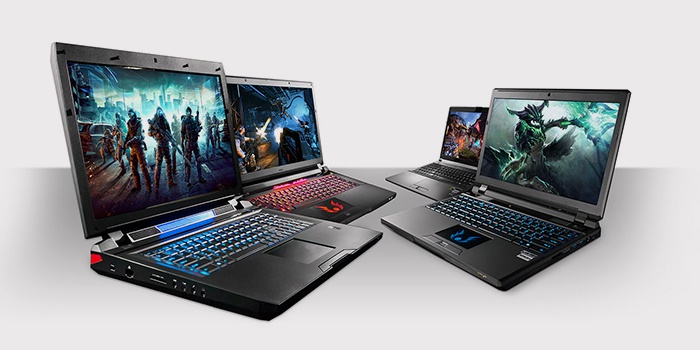
For games
Games require enormous power from processors. Quad-core AMD Athlone 2 with a frequency of 2800 MHz in this regard will be best choice than a 2-core Intel Core i5, because the graphics will be at a high level. If you reduce the initial voltage on an AMD chip from 1.4 volts to 1.2, the overall electricity consumption is reduced by 30%, which makes it as economical as Intel, but better in performance. To overclock the chip, you need to return the factory voltage. When preparing your gaming laptop, be sure to apply a good quality thermal paste during assembly to protect against overheating.

For home or office work
The main tasks solved at home and in the office are working with text, surfing the net, processing photos, watching videos. Purchasing a super-powerful processor with this usage model is not practical. To solve such problems, a dual-core Intel Core i3 chip will be quite enough. He can handle everyone easily office programs, browsers, simple graphic editors and music and video players.
For working with demanding programs
If the laptop is a designer's tool, used for video editing, developing graphic projects or presentations, it cannot be considered as an office or home laptop. Such devices are needed to quickly develop a project with a client, draw up cost estimates and show the advantages/disadvantages of certain solutions. The speed of computing processes should be maximum.
For such a laptop you can only use processors from Intel from Core series i5. The built-in graphics core will save not only on the cost of the video card, but also on energy consumption. If the laptop will be used for video processing, you should choose Intel Core i7 Sandy Bridge with a video card of the appropriate performance class.
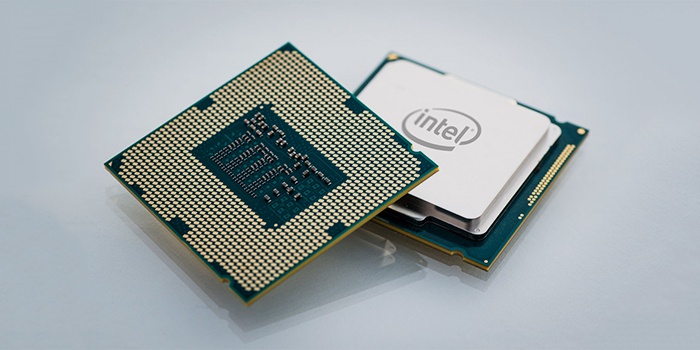
Rating of laptop processors by performance 2016-2017
Currently, AMD and Intel have released a large number of chips to meet the demand in all market segments. TOP laptop processors include several competing models:
- AMD FX Vishera – shows the highest frequency at this moment(4700 MHz). Depending on the tasks being solved, 4 or 8 cores work. Designed to work on gaming PCs and laptops. High performance is ensured not only by the frequency of this processor, but also by the largest L2 and L3 cache volumes on the market.
- Intel Core i7 Devil's Canyon - designed for working with resource-intensive programs for video processing, 3D modeling, project development, and managing complex computing processes. Increased energy efficiency is clearly visible in battery saving.
- Intel Core i7 Skylake is a quad-core chip designed to solve computing problems. He is capable of working with demanding programs on modeling, video content creation, development, testing software and process management. Has the lowest power consumption among competitors in its class.
Video: how to choose a processor for a laptop
The video presents a comparison of laptop processors using specialized software. Testing takes place in conditions where the chip is “squeezed out” maximum performance. The video will be interesting to those who are deciding on the choice of the most powerful device for their computer. The results of the review are clearly shown in the form of graphs, comparative tables and diagrams. Comments from a specialist during the test will help even beginners understand the issue of choice and will help professional computer assemblers.




